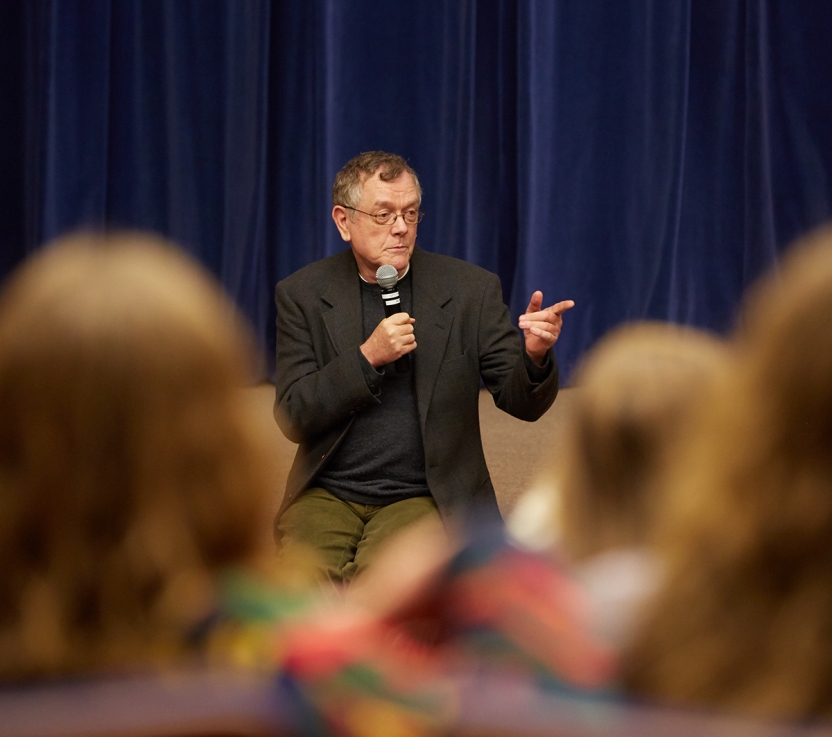Author Speaks About the Racism Within

MIDDLEBURY, Vt. – At the age of 12, writer Jim Grimsley got the first inkling that he might be racist. He was a sixth grader in a small North Carolina school when his principal ushered three black girls into the all-white classroom. It was the mid-1960s and the start of desegregation in his town. On that first day, when the teacher had briefly left the room, Grimsley hoped to get a laugh from his classmates by taunting one of the new girls. “You black bitch,” he said.
Given everything he had learned about black people, he expected she would cower, feel ashamed, and passively agree that she was inferior. But her reaction set him on his heels. In a booming voice she shot back, “You white cracker bitch!” He was dumbfounded, shocked by the girl’s fearless self-confidence, which contradicted everything he had been taught about how she should respond.
“That was the most important moment in my life up until that day,” said Grimsley. “I was being offered an opportunity to see the racism, the bigotry that had been programmed inside me and I was being offered the chance to change.”
“Black Bitch” is the first chapter of Grimsley’s 2015 memoir How I Shed My Skin: Unlearning the Racist Lessons of a Southern Childhood. The prolific author and playwright, who is professor of practice at Emory University, spoke before a gathering of students, faculty, and staff at Dana Auditorium on October 27.
“In sharing his childhood, Jim has shed light on how integration affected children differently than adults,” said President Laurie Patton in her introductory remarks. “And in being here tonight, we have a unique opportunity to look at the issue of how and why we make someone ‘other’ through Jim’s honest exploration of his experiences, and through his own personal lens.”
At the time of Grimsley’s sixth-grade encounter, North Carolina was going through a program called “Freedom of Choice,” which was the state’s last-ditch effort to stave off school integration and preserve segregation. By his eighth-grade year, the Supreme Court ruled that Freedom of Choice was not adequate and that states had to comply with Brown vs. Board of Education, a ruling made a dozen years earlier, by consolidating and integrating their schools.
Grimsley said that when integration finally took hold in earnest, private white schools began to sprout up out of nowhere, a trend he described as the privatization of segregation. Grimsley, however, attended what had formerly been the black students’ middle school.
“In the book, what I try to trace is the effect this had on me, to meet the other half of my community, whom I’d been living with all my life, whom I had never known, never had any kind of social dealings with.” He began to realize that what he had been taught for so many years was faulty, and being in class with these kids for many hours, day after day, broke down barriers. They started to deal with each other as kids. But that was only true for about a third of the classroom, he noted. The other two thirds either shunned or teased their black classmates.
Exploring the origins of his racial thinking, Grimsley looked to some of the big influencers in his childhood. He says the church was where he learned the idea that black was the opposite of white, a notion that was reinforced continually in scriptural symbolism and in conversations among parishioners.
“That opposition became one of the patterns that enabled me to sort through the world,” he said. And the message continued beyond the walls of the church – on tv, good cowboys wore white hats, bad ones wore black; in fantasy, white magic is positive, black magic is evil; he learned to love the light, but fear the dark – the examples were endless and pervasive.
Grimsley realized that as he progressed through middle school and high school, he had to make a choice: “to become a better bigot or to stop being a bigot.”
“When you’re programmed at such a young age to think something, you don’t just stop thinking it because you want to,” said Grimsley. “That’s one of the places where we, as white people, continue to fail on this issue – we think one day we’re not racist…Even if we don’t think of it consciously, that programming is inside of us and it’s very, very difficult to escape it. I know that I never have. What I’ve learned to do is to short circuit it; to refuse to allow it to act on me anymore, and to be a different person.”
Grimsley’s appearance was sponsored by Alliance for an Inclusive Middlebury, a campus organization that works to promote a college-wide approach to issues of diversity, access, and equity.

